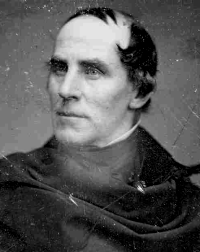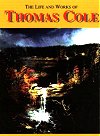|
|
Thomas Cole (1801-1848)
Thomas Cole was born Feb. 1, 1801 in Lancashire, England. In 1819, he sailed with his family to Philadelphia. After working for a time as an engraver there, Cole travelled, mostly on foot, to Ohio to rejoin his family. After two years working in his father's small wallpaper factory, Cole struck out on his own again, walking from town to town in Ohio, painting portraits and playing the flute to support himself.
He returned to help his family move from Ohio to Pittsburgh, before returning to Philadelphia in Nov. 1823. Financially, Cole fared just as badly there, but, studying at the Pennsylvania Academy Of Fine Arts, his painting technique was refined and improved. In April, 1825 Cole left Philadelphia to rejoin his family, now living in New York. |
 |
It was in New York, that Cole's fortunes changed. He spent the summer of 1825 walking and sketching the Hudson Valley and the Catskills. The resulting paintings, displayed in the window of a local shop, caught the notice of fellow artist John Trumbull. The paintings displayed included "The Falls Of Kaaterskill" (which Trumbull bought for $25) and "Lake With Dead Trees". Trumbull introduced him to Asher Durant and William Dunlap. Though it would be years before it was recognized, the Hudson River School of landscape painting had started. |
Each following summer, Cole returned to the Catskill Mountains, armed with his sketchbook, sometimes staying at the Catskill Mountain House. Although he did not particularly like the Mountain House - he preferred tramping through the wilderness and staying at small country inns - his visits served to increase the popularity of the fledgling hotel. |
"Kaaterskill Falls", 1826
"The Clove, Catskills", 1827
"Landscape, Composition, St. John in the Wilderness", 1827
|
In 1829 he sailed to Europe, where he visited galleries and studied art in London, Paris, Florence, Rome and Naples, returning to America in 1832. Four years later, in 1836, Cole finished painting a series of 5 massive canvasses, The Course of the Empire. The paintings, depicting the stages of a great empire from creation to decay, were not well received by critics, with many saying he had lost his creative edge while in Europe. It could also be argued that it was, polically, not a popular idea that our new nation, full of the promise and idealism depicted in the first 3 paintings, would end up in ruins as in the last. |
"The Course of Empire: The Savage State", 1834
"The Course of Empire: The Pastoral or Arcadian State", 1834
"The Course of Empire: The Consummation of Empire", 1835
"The Course of Empire: Destruction", 1836
"The Course of Empire: Desolation", 1836 |
In Nov. 1836, one month after first exhibiting The Course of the Empire, Cole married Maria Bartow and the couple moved permanently to a house in Catskill. In 1841, Cole finished his second series; 4 canvasses entitled The Voyage of Life. It's religous tone, the theme of life and death, and Cole's mastery of color and light, made this series more widely accepted than the first series. |
"The Voyage of Life: Childhood", 1841
"The Voyage of Life: Youth", 1841
"The Voyage of Life: Manhood", 1841
"The Voyage of Life: Old Age", 1841 |
Cole left on his last trip to Europe in Aug., 1841. On his return the following March, he wrote in a letter to C. Greene, the US consul in Rome: "Must I tell you that nether the Alps nor the Appenines, no, nor even Aetna itself, have dimmed, in my eyes, the beauty of our own Catskills? It seems to me that I look on American scenery, if it were possible, with increased pleasure. It has it's own peculiar charm - a something not fond elsewhere. I am content with nature: would that I were with art!" |
"The Architect's Dream", 1840
"Roman Campagna (Ruins of Aqueducts in the Campagna di Roma)", 1843
"Mount Aetna from Taormina", 1843
"Catskill Mountain House: The Four Elements", 1843-44
"The Hunter's Return", 1845
"Home in the Woods", 1847 |
Cole's work becomes increasingly religous during his final years. He joined the Episcopal Church and in 1844 he took on artist Frederick Church as his apprentice. In Oct. 1847, he climbed his last Catskill peak - Overlook Mountain, above Woodstock. The following year, before the snow had cleared his beloved Catskills, he had died. |
|
The photo is from a daguerrotype in the collection of the Library Of Congree. It was taken between 1844 and 1848, by the Mathew Brady Studio.. All images of paintings load in a seperate browser window from Wikipedia, the free encyclopedia. |

Much of the above information is from The Life And Works Of Thomas Cole by Louis Legrand Noble, Cole's parson and friend; originally published in 1853, now reprinted in paperback by Black Dome Press (ISBN 1-883789-13-3). |
|







